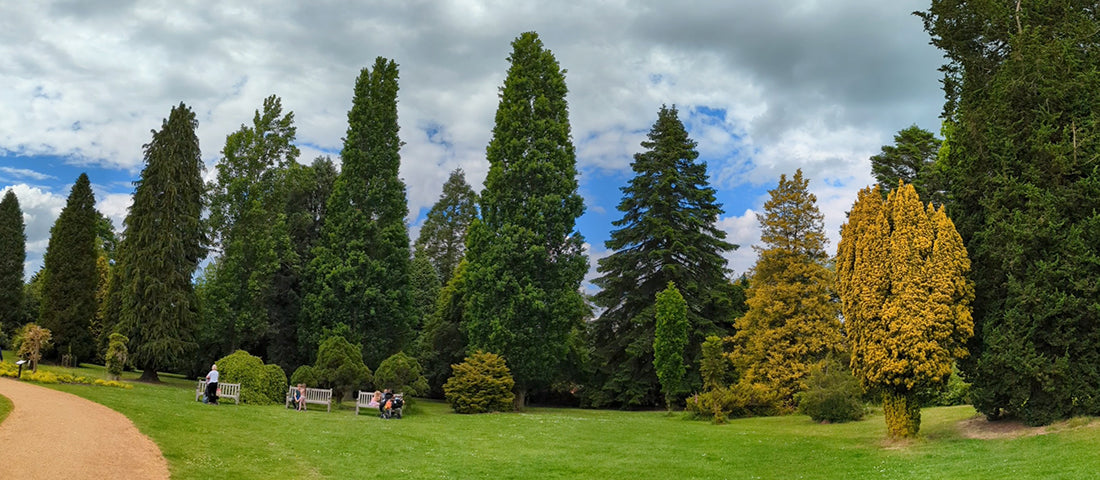
We recently had the opportunity to join a Garden Media Guild guided tour of the Sir Harold Hillier Gardens in Hampshire. Not only we were shown round by the gardens’ curator David Jewell, but when we arrived we learned that we would also be accompanied by renowned plantsman Roy Lancaster, the garden’s first curator. What could be more special?!
The garden was originally established by Sir Harold Hillier, one of only two people to have been knighted for horticulture, the other being Sir Harry Veitch. When Sir Harold moved to Jermyn House near Romsey in 1953, the property had 40 acres of open grass paddock – and no running water or electricity. Since then the site has expanded to cover 180 acres. It’s the most wonderful garden to visit at any time of year; in fact it’s one of the UK’s best winter gardens.
Visitors can see a massive 12,500 taxa there, and discover more than 600 champion trees. A tree qualifies as a champion when it's an exceptional example of its species because of its enormous size, great age, rarity or historical significance. The opportunity to see 600 in one place is astonishing - it's more than double the number which can be seen at Kew Gardens.
What really came across during our visit was David and Roy’s deep knowledge of the gardens. They both know each individual tree. Not just the species name, but when it was planted, who planted it, where the seeds came from, when and how it may have lost a branch… to wander with such a living archive of knowledge was a real privilege.

The visit was packed with highlights as particular trees, shrubs and flowers were pointed out, many at their best in early June. A Himalayan evergreen dogwood (cornus capitata) was looking beautiful, laden with creamy white bracts. The peony border was a joy; David highlighted ‘Jan Van Leeuwen’, describing white and yellow as the two strongest colours in the garden. A Chinese magnolia (Magnolia sieboldii subsp. sinensis) was adorned with delightful cup-scaped, crimson-centred flowers with the most heavenly fragrance – we caught the scent before we could view the blooms up close. Simply gorgeous.

The wisteria were fading from their May peak, but the growing technique was fascinating. Grown on poles, many types could be grown in a small area. What a great idea for those of us who adore wisteria but who have limited space.
The 250m long herbaceous border was also at its early-summer best. It’s one of the longest borders in the UK, although it’s now been overtaken by Kew’s 320m Great Broad Walk Borders, which opened in 2016. The border was given a refresh when David arrived as curator 12 years ago, and it’s packed with inspiration, designed for a long season of interest. Pointing out some of the patterns which drew the varied planting together, David quoted what he described as the best advice he’d ever been given: if in doubt, repeat.


Today the Sir Harold Hillier Gardens describes its mission as Conservation, Preservation, Education, Recreation. Certainly the gardens have provided invaluable open space for local people over the last couple of years. Looking to the future, we heard about plans for a new garden being created in collaboration with Tom Stuart-Smith, and new ways of giving an enjoyable and fulfilling visit to the 250,000 people who now visit the site annually.
David spoke about the challenges of climate change, and how planting is changing with it. Twenty years ago, the gardens didn’t plant cannas outdoors; now they’re kept outside all year round. The new garden is being created with a view to resilience, with wet winters as well as periods of drought expected to become more frequent. The new garden is being designed to push the boundaries of gardening. The substrate will be a mixture of crushed rock and just 10 per cent soil, with a planting ethos of ‘plant it, drown, it, forget it’. It sounds fascinating.
It's clear that the Sir Harold Hillier Gardens are adapting to a changing future – and we can’t wait to see what comes next in the story.
o0o

With thanks to David Jewell, Roy Lancaster CBE and the Sir Harold Hillier Gardens for giving so generously of their time, and to the Garden Media Guild for arranging the tour.
Bee on white peony image above: © Fiona Walsh Photography, 2022. Thanks to Fiona for her kind permission to feature her photography from the day.

